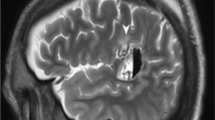Abstract
Introduction
Ganglioglioma is an uncommon neoplasm of the central nervous system, most frequently seen in the temporal lobe, and usually associated with medically refractory epilepsy in children and young adults. Few reports have considered ganglioglioma-associated epileptogenicity arising in the temporal lobe. The purpose of our study was to define the imaging features of ganglioglioma in the temporal lobe and their relation to the seizure foci revealed by electrocorticograms.
Materials and methods
We reviewed 24 patients with pathologically confirmed ganglioglioma in the temporal lobe.
Results
Computed tomography (CT) images showed gangliogliomas to be isodense (91.7%), and on T1-weighted images (T1-WI) most gangliogliomas (79.2%) were isointense to the gray matter. A cystic lesion was seen in 14 of 24 of the gangliogliomas (58.3%). Mass effects were not seen in any of the ten tumors without cystic components. One patient showed tumor recurrence. Dual pathology was seen in two cases (8.3%). In 23 cases, epileptogenicity was confirmed in the tumors by intraoperative electrocorticogram. The remaining case had no epileptogenicity.
Conclusion
A tumor presenting isointensity to gray matter on T1-WI without mass effects in the medial temporal lobe in a young patient with temporal lobe epilepsy (TLE) might be the characteristic imaging of temporal lobe ganglioglioma. However, such tumors are not always associated with epileptogenicity, even if a ganglioglioma is found in a patient with TLE. The seizure foci may be contralateral to the ganglioglioma. Therefore, we need to investigate the hippocampus, white matter abnormalities of the ipsilateral and contralateral anterior temporal lobe, and other focal lesions closely.




Similar content being viewed by others
References
Koeller KK, Henry JA (2001) Superficial gliomas: radiologic–pathologic correlation. Radiographics 21:1533–1556
Adachi Y, Yagishita A, Arai N (2006) White matter abnormalities in the anterior temporal lobe suggests the side of the seizure foci in temporal lobe epilepsy. Neuroradiology 48(7):460–464 Jul
Kuzniecky RI, Jackson GD (eds) (2005) Magnetic resonance in epilepsy, 2nd ed. Elsevier, Philadelphia, pp 99–160
Trescher WH, Lesser RP (1996) The epilepsies. In: Bradley WG, Daroff RB, Fenichel GM, Marsden CD (eds) Neurology in clinical practice: the neurological disorders vol. 2. 2nd edn. Butterworth-Heinemann, Boston, pp 1625–1654
Brainer-Lima PT, Brainer-Lima AM, Azevedo- HR (2006) Ganglioglioma: comparison with other low-grade brain tumors. Arq Neuropsiquiatr 64(3A):613–618
Zentner J, Wolg HK, Ostertun B (1994) Gangliogliomas: clinical, radiological, and histopathological findings in 51 patients. J Neurol Neurosurg Psychiatry 57(12):1497–502
Zhang D, Henning TD, Zou LG, Hu LB, Wen L et al (2008) Intracranial ganglioglioma: clinicopathological and MRI findings in 16 patients. Clin Radiol 63:80–91
Fernandez C, Girard N, Paredes AP et al (2003) The usefulness of MR imaging in the diagnosis of dysembryoplastic neuroepithelial tumor in children: a study of 14 cases. AJNR Am J Neuroradiol 24:829–834
Provenzale J, Ali U, Barboriak DP et al (2000) Comparison of patient age with MR imaging features of gangliogliomas. AJR Am J Roentgenol 174:859–862
Crespo-Rodrigues AM, Smirniotopoulos JG, Rushing EJ (2007) MR and CT imaging of 24 pleomorphic xanthoastrocytomas (PXA) and a review of the literature. Neuroradiology 49:304–315
Osborn AG, Blaser SI, Salzman KL et al (2004) Diagnostic imaging: brain. Amirsys, Salt Lake City, Utah pp I(6):34–37
Grossman RI, Yousem DM (eds) (2003) Neuroradiology: the requisites, 2nd ed. Elsevier, Philadelphia, pp 141–146
Kleihues P, Cavenee WK (2000) Pathology and genetics of tumors of the nervous system. In: Nelson JS, Bruner JM, Wiestler OD, VandenBerg SR (eds) Ganglioglioma and gangliocytoma. IARC (International Agency for Research on Cancer), Lyon, pp 56–61
Salanova V, Markand O, Worth R (2004) Temporal lobe epilepsy: analysis of patients with dual pathology. Acta Neurol Scand 109:126–131
Cendes F, Li LM, Andermann F et al (1999) Dual pathology and its clinical relevance. Adv Neurol 81:153–164
Guilinoni M, Galassi E, Zucchelli M, Volpi L (2005) Seizure outcome of lesionectomy in glioneuronal tumors associated with epilepsy in children. J Neurosurg 102:283–293
Nakajima M, Kidooka M, Nakasu S (1998) Anaplastic ganglioglioma with dissemination to the spinal cord: a case report. Surg Neurol 49(4):445–448
Luyken C, Blumcke I, Fimmers R (2004) Supratentorial gangliogliomas: histopathologic grading and tumor recurrence in 184 patients with a median follow-up of 8 years. Cancer 101:146–155
Im SH, Chung CK, Wang KC et al (2002) Intracranial ganglioglioma: preoperative characteristics and oncologic outcome after surgery. J Neurooncol 59(2):173–83
Hukin J, Siffert J, Cohen H et al (2003) Leptomeningeal dissemination at diagnosis of pediatric low-grade neuroepithelial tumors. Neuro-oncology 5:188–196
Conflict of interest statement
The authors declare that they have no conflict of interest.
Author information
Authors and Affiliations
Corresponding author
Rights and permissions
About this article
Cite this article
Adachi, Y., Yagishita, A. Gangliogliomas: characteristic imaging findings and role in the temporal lobe epilepsy. Neuroradiology 50, 829–834 (2008). https://doi.org/10.1007/s00234-008-0410-x
Received:
Accepted:
Published:
Issue Date:
DOI: https://doi.org/10.1007/s00234-008-0410-x




